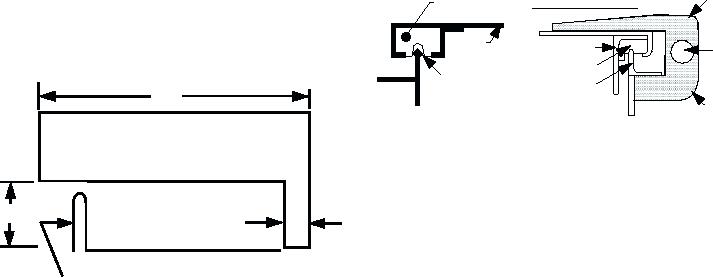
an effective gauge for doing this (fig. 3-12). A
knife-edge that is too high damages the gasket; a
knife-edge that is too low damages the hinges as a
HINGE
WATERTIGHT HATCH
RUBBER
BLADE
result of over-adjusting the door in attempting to
GASKET
maintain a watertight seal. If the knife-edge is more
GASKET
DOOR
RETAINER
than 1/8 inch too high or too short, it must be repaired.
HINGE
PIN
GASKET
BAD GASKET:
KNIFE-
NOTE PERMANENT
EDGE
6"
SET
HINGE
PAD
DCf0313
Figure 3-13. Gasket inspection.
1-11/16"
5/8"
The chalk test is a simple means of determining if
the gasket is in continuous contact with the knife-edge
KNIFE EDGE
when a closure is dogged. A successful chalk test does
DCf0312
not guarantee that a closure is watertight, but if the
gasket is in good condition and the dogs are properly
Figure 3-12. Gauge for measuring knife-edge height.
adjusted, it does provide a reasonable assurance of
watertight integrity.
For steel knife-edges, repair a nicked or short
knife-edge by building up the area with
The steps of the procedure for the chalk test for
corrosion-resistant stainless steel electrode and filing it
doors, hatches, and scuttles are as follows:
with a flat file. Grind a high knife-edge to shorten it to
1. Clean the knife-edge.
the required height. The use of power grinders on a
2. Clean the gasket.
knife-edge is not recommended. Straighten bent
knife-edges by reshaping with a hammer or by bending.
3. Rub chalk on the knife-edge.
For aluminum knife-edges, do not attempt to build
4. Close and dog the closure tightly.
up a short knife-edge. Report the closure to your repair
5. While the closure is dogged down, check for
division for repair. Use only a fine file to file down high
any loose dogs. If any dog is loose, it will need
knife-edges, and avoid leaving grooves in the edge.
to be adjusted and the chalk test repeated.
Use a steel striker plate when hammering a bent
aluminum knife-edge to avoid denting the aluminum.
6. Open the closure and observe the imprint of
chalk on the gasket. The chalk imprint should
Rubber gaskets are installed in watertight closures
be in the center of the gasket. If the chalk line is
to provide a watertight fit all-around when they bear
not continuous, the closure is not watertight
against the knife-edge. Inspect the gasket (fig. 3-13)
and requires further adjustment or repair. For
for the following:
f u r t h e r i n f o r m a t i o n , r e f e r t o NAV S E A
The rubber must be soft and pliable and have no
Publication S9169-AW-DCB-010.
cracks.
Faulty gaskets are a main source of leakage
There should be no paint, rust, or other foreign
through closures. Rubber gaskets (fig. 3-14) are
matter.
installed in doors, hatches, scuttles, air ports, and
The gasket joint should be located at the top of
dogged manholes to provide a tight fit all-around.
When exposed to oil, grease, heat, or paint, the gaskets
the door.
begin to deteriorate. Gaskets should be protected from
There must not be any gaps in the gasket joint.
exposure to substances or conditions that cause
Replace the gasket if shrinkage has caused
deterioration. Replace them immediately when they
separation where the two ends join.
show signs of deterioration. Inspect them frequently to
A permanent set or groove in the rubber may not
detect hardness, cracks, or permanent set (indentation)
greater than 1/8 inch.
be greater than 1/8 inch deep.
3-10

